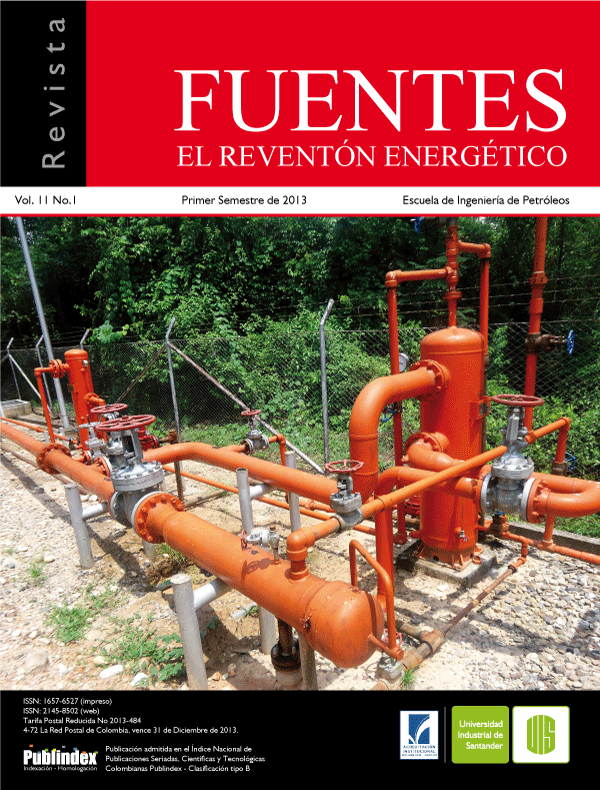Modeling of prediction effectiveness of chemicals treatments for removing to organics deposits of crude oil by rmn1h and chemometrics
Published 2013-11-06
Keywords
- Reservoir damage,
- 1H NMR,
- Chemometrics,
- Functional groups,
- Chemical treatments
- Organics deposits,
- Paraffin ...More
How to Cite
Abstract
One of the most common problems presented in oil production worldwide are paraffinic deposits, which occur due to changes in the thermodynamic conditions of the original oil. When this material is deposited in the formation, causes a permeability reduction of the flow channels causing a plugging in the perforations, increasing damage to the formation and decreasing the fluid flow.
The difficulty in finding new reserves, has led the industry to focus on mature fields in order to increase the recovery factor. Historically Colorado Field, has presented precipitation and deposition of paraffin; this is evidenced by the drastic fall of the production and in the periodical cleaning processes and closure of wells. One of the most common method used for removing of paraffin is the chemical treatment, which requires a previous analysis and compatibility tests to determine the feasibility of the chemical being injected. This research headed to the developing a prediction model for the effectiveness results of chemical treatments for removing of paraffin from the results obtained by the 1H-NMR technique, Chemometrics and compatibility testing.
The development of this research helped to define the most significant functional groups presented in the chemical treatments feasible to apply for paraffin deposits remotion of the Mugrosa formation of Colorado Field and leaves a base for development of new products; also poses a methodology for the selection of new chemical treatments using a statistical model for predicting, preventing routine testing with rock and fluids, saving time and resources, this can be replicated to other fields with similar problems.
Downloads
References
2. JaIMES, M. MEDINa, C. ZaPaTa, J. HERNaNDEZ, S. Control de Parafinas Campo Lisama. Gerencia Regional del Magdalena Medio – ICP. 2005.
3. QUINTERO, Mario. Generación de un modelo de predicción de la remoción de depósitos orgánicos del Campo Colorado a partir de los grupos funcionales presentes en tratamientos químicos determinado por RMN-1H y Métodos Quimiométricos. Tesis de Pregrado. Director: Daniel Ricardo Molina. Universidad Industrial de Santander, Escuela de Química, 2012.
4. ISLAS SILVA, C. “Manual de Estimulación Matricial de Pozos Petroleros”. Colegio de Ingenieros Petroleros de México. México, 1991.
5. POvEDa, Diana. “Diseño de un Tratamiento Químico para Remover Depósitos Orgánicos a Nivel de la Cara de la Formación. Aplicación Campo Colorado”. Tesis de Maestría. Director: viatcheslav Kafarov. Universidad Industrial de Santander, Escuela de Ingeniería Química, 2009.
6. ARIZA, Emiliano. “Determinación del Umbral de Cristalización de las Parafinas en el Crudo del Campo Colorado”. Director: fernando Enrique Calvete Gonzalez. Tesis de Maestría. Universidad Industrial de Santander, Escuela de Ingeniería de Petróleos, 2008.
7. BENavIDES, Maria, SaINT MaRCOUX Jean francois and BaRRUfET Maria. “Dilution Strategies for Wax and Control for Deepwater Development from a flow assurance Perspective: Part I-Current Practice and Perspective”. SPE annual Technical Conference and Exhibition, (26-29 September 2004), 2004. ISBN: 978-1-55563-151-2.
8. MOLINa D., NavaRRO U., MURGICH J. “Correlations between SaRa fractions and physicochemical properties with 1H spectra of vacuum residues from Colombian crude oils”. Fuel. 2010, vol 89, p. 185-192.
9. POVEDA J., Juan Carlos. “Caracterización estructural de fracciones pesadas del petróleo mediante técnicas espectroscópicas”. Director: Daniel Ricardo Molina. Tesis de Pregrado. Universidad Industrial de Santander. 2003. p. 4-5, 25-29.
10. YaNG Y., LIU, B., Xi H., SUN X., ZHaNG T. “Study on relationship between the concentration of hydrocarbon groups in heavy oils and their structural parameter 1H-NMR spectra”. Fuel. 2003. vol 82, p. 721-727.
11. CRISTaNTE M., SELvES J., GRaSSY G., Collin J. “Structure-activity relationship study on paraffin inhibitors for crude oils (INIPaR model II)”. Analytica Chemical Acta.1993. vol 274, p. 303-316.
12. MOLINa, D., NavaRRO, U., MURGICH, J. “Partial Least-Squares (PLS) correlation between refined product yields and physicochemical properties with the 1H Nuclear Magnetic Resonance (NMR) spectra of Colombian crude oils”. Energy & Fuels. 2007, vol 21, p. 1674 -1680.
13. GaRCÍa, María del Carmen. “Paraffin Deposition in Oil Production”. SPE International Symposium on Oilfield Chemistry, (13-16 february 2001), 2001. ISBN: 978-1-55563-924-2.
14. CHavaRRIa, Sandra y NIÑO, a. “Evaluación del daño a la formación por precipitación de parafinas y asfaltenos en el Campo Colorado”. Tesis de Pregrado. Universidad Industrial de Santander, escuela de Ingeniería de Petróleos, 2010.
15. aBDaLLaH, Wael., Et. al. fundamentos de la mojabilidad. Schlumberger. [en línea]. 2007. Disponible en internet: http://www.slb.com/~/media/files/resources/oilfield_review/spanish07/aut07/p44_61.pdf
16. American Petroleum Institute. Laboratory testing of surface active agents for well stimulation. API RP 42. Second Edition. Washington D.C., 1977.
17. RODRIGUEZ, R. y MEDINA, C. “Pruebas con tensoactivos y disolventes para eliminar bloqueos causados por precipitación de parafinas en tubería, perforaciones y cara de la formación”. Ecopetrol. El Centro, Octubre de 1996.
